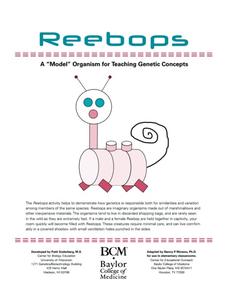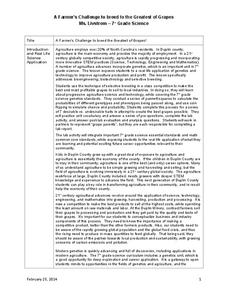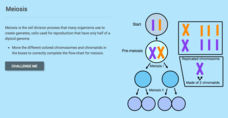Towson University
Mystery of the Crooked Cell
Can your class solve the Mystery of the Crooked Cell? Junior geneticists collaborate to learn about sickle cell anemia in a fascinating lesson plan. The included materials help them to examine the genetic factors behind the disease...
Baylor College
Reebops: A “Model” Organism for Teaching Genetic Concepts
In a sweet simulation, junior geneticists examine the chromosomes of a fictitious Reebop marshmallow animal, combine chromosomes to produce offspring, and then make a model of the resulting Reebop baby. Phenotypes include number of...
Scholastic
Study Jams! Heredity
Mia wishes her blue hair was inherited so that she wouldn't have to dye it, but Sam explains that eye color is. The video does not expound upon the concept of alleles. It does, however, describe inherited traits vs. learned behavior, and...
Beyond Benign
What is Biotechnology
Examine the sequence of key events in the history of genetics. An engaging lesson asks scholars to sort events to create a timeline of biotechnology milestones. Arranging the events gives learners a perspective on the development of...
Beyond Benign
Kitten Creation
Your pupils become geneticists as they create cat offspring. The next lesson in a series continues an exploration of genetic makeup as scholars consider parent traits to build their offspring. Using household items, they create kittens...
Beyond Benign
Lucky Brand Genes: Chromosome Cookies
Mutations are not just deformed creatures we see in movies—they happen every day! Scholars study the different types of genetic mutations in the 12th installment of a series of 18 lessons. A creative activity uses candy and other food...
Beyond Benign
Lucky Brand Genes: Genetic Traits
Explore single-gene traits in humans. After viewing a video introducing genetic vocabulary, individuals identify their phenotype and possible genotypes of specific traits. They consider both dominant and recessive traits. This is the...
Beyond Benign
Who’s Your Daddy? Finding the Father
Time for the reveal! The nineth lesson plan of the series of 18 has scholars compare DNA fingerprints of cats to their samples to identify the father of Sparky's kittens from previous lessons. They analyze the DNA bands to determine the...
Beyond Benign
Gelin’: Gel Electrophoresis Simulation
Take a look at a DNA fingerprint. Scholars run a gel electrophoresis simulation to examine the DNA of potential father cats in the eighth installment of an 18-part series. The lesson continues the series that explores DNA and its...
Howard Hughes Medical Institute
Lactose Intolerance: Fact or Fiction
Around the world, about 2/3 of adult humans are lactose intolerant. Scholars work in small groups to discuss a few statements about lactose intolerance. Then, they watch a video on the topic and readdress each statement. Whole-class...
Howard Hughes Medical Institute
Using Genetic Crosses to Analyze a Stickleback Trait
Two fish appear different, but how do scientists determine their genotypes? Scholars practice performing test crosses to determine the genotypes of fish given their phenotypes. They answer in-depth comprehension questions and complete...
Kenan Fellows
A Farmer’s Challenge to Breed to the Greatest of Grapes
What does your class know about GMOs? Are they savvy to selective breeding? Challenge young minds to engineer the greatest crop of all time using a hands-on genetics unit. Learners discover the good and bad details of selective breeding,...
Science 4 Inquiry
Body in Balance
The human body maintains homeostasis through the interconnection of multiple systems. Young scientists match these connections and discuss how they relate to each other. They apply their knowledge to solve the mystery of a treasure hunter.
Science 4 Inquiry
Monster Mash-Up of Genetics
It's alive! Young mad scientists create monsters as they explore the probabilities of genetic traits during a well-structured inquiry lesson. Pairs travel from station to station, rolling the dice and adding traits to their creations as...
Beyond Benign
Punnett Square Possibilities
Discover possible genetic outcomes through Punnett Squares. Learners continue studying genetic traits in the 10th lesson in the 17-part series. After determining the father of Sparky's kittens, scholars now attempt to predict the traits...
CK-12 Foundation
Cell Cycle: Phases of the Cell Cycle
Eukaryotic cells go through a cycle of creation, reproduction, and death. The video choreographs the cell cycle to music from a popular movie. This prepares scholars to answer the questions in the online interactive.
CK-12 Foundation
Meiosis
"We Are Never Ever Getting Back Together" makes the perfect theme song for meiosis. The simulation encourages scholars to move the chromosomes and chromatids to properly illustrate the meiosis break up. Multiple-choice questions allow...
Scholastic
Back from the Dead
If you could bring back one extinct animal, what would it be? That is the question your class will ponder. Your budding scientists read a passage, follow a cloning timeline, and review a diagram about the process of reviving a woolly...
University of Colorado
Punnett Squares with Piebald Deer
Explore the science behind Earth's amazing diversity of life with this instructional activity on genetics. Looking at specific traits in piebald deer, carnations, and roan cattle, young scientists use Punnett squares to determine the...
US National Library of Medicine
Monster Genetics Lab
Harness young scientists' knowledge of genetics with an engaging science activity. Students start by flipping a coin to determine the genotypes and phenotypes of two parent monsters, before using Punnett squares to determine the...
Oklahoma State University
Hairy Heredity
Young scholars learn that heredity comes down to the flip of a coin with this cross-curricular math and science lesson. Using smiley faces as a model, students toss coins to determine which dominant or recessive traits will be passed on...
BBSRC
Discovering DNA: The Recipe for Life
A pinch of adenine, a dash of thymine and ta-da, you have life! Well, it's not quite that simple, but through this series of activities and experiments young scientists learn about the structure of DNA and how it contains the recipe for...
Cmassengale
Bacteria: Structure and Function
For as small as they are, there sure is a lot of information for young scientists to learn about bacteria. Help simplify the subject with this instructional presentation that explores the structure, nutrition, and reproduction of...























